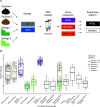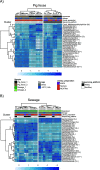Library Preparation and Sequencing Platform Introduce Bias in Metagenomic-Based Characterizations of Microbiomes
- PMID: 35289669
- PMCID: PMC9045301
- DOI: 10.1128/spectrum.00090-22
Library Preparation and Sequencing Platform Introduce Bias in Metagenomic-Based Characterizations of Microbiomes
Abstract
Metagenomics is increasingly used to describe microbial communities in biological specimens. Ideally, the steps involved in the processing of the biological specimens should not change the microbiome composition in a way that it could lead to false interpretations of inferred microbial community composition. Common steps in sample preparation include sample collection, storage, DNA isolation, library preparation, and DNA sequencing. Here, we assess the effect of three library preparation kits and two DNA sequencing platforms. Of the library preparation kits, one involved a PCR step (Nextera), and two were PCR free (NEXTflex and KAPA). We sequenced the libraries on Illumina HiSeq and NextSeq platforms. As example microbiomes, two pig fecal samples and two sewage samples of which aliquots were stored at different storage conditions (immediate processing and storage at -80°C) were assessed. All DNA isolations were performed in duplicate, totaling 80 samples, excluding controls. We found that both library preparation and sequencing platform had systematic effects on the inferred microbial community composition. The different sequencing platforms introduced more variation than library preparation and freezing the samples. The results highlight that all sample processing steps need to be considered when comparing studies. Standardization of sample processing is key to generating comparable data within a study, and comparisons of differently generated data, such as in a meta-analysis, should be performed cautiously. IMPORTANCE Previous research has reported effects of sample storage conditions and DNA isolation procedures on metagenomics-based microbiome composition; however, the effect of library preparation and DNA sequencing in metagenomics has not been thoroughly assessed. Here, we provide evidence that library preparation and sequencing platform introduce systematic biases in the metagenomic-based characterization of microbial communities. These findings suggest that library preparation and sequencing are important parameters to keep consistent when aiming to detect small changes in microbiome community structure. Overall, we recommend that all samples in a microbiome study are processed in the same way to limit unwanted variations that could lead to false conclusions. Furthermore, if we are to obtain a more holistic insight from microbiome data generated around the world, we will need to provide more detailed sample metadata, including information about the different sample processing procedures, together with the DNA sequencing data at the public repositories.
Keywords: DNA sequencing; library preparation; metadata; metagenomics; microbial communities; microbiome.
Conflict of interest statement
The authors declare no conflict of interest.
Figures



References
-
- Qin J, Li Y, Cai Z, Li S, Zhu J, Zhang F, Liang S, Zhang W, Guan Y, Shen D, Peng Y, Zhang D, Jie Z, Wu W, Qin Y, Xue W, Li J, Han L, Lu D, Wu P, Dai Y, Sun X, Li Z, Tang A, Zhong S, Li X, Chen W, Xu R, Wang M, Feng Q, Gong M, Yu J, Zhang Y, Zhang M, Hansen T, Sanchez G, Raes J, Falony G, Okuda S, Almeida M, LeChatelier E, Renault P, Pons N, Batto J-M, Zhang Z, Chen H, Yang R, Zheng W, Li S, Yang H, et al. 2012. A metagenome-wide association study of gut microbiota in type 2 diabetes. Nature 490:55–60. doi: 10.1038/nature11450. - DOI - PubMed
-
- Gevers D, Kugathasan S, Denson LA, Vázquez-Baeza Y, Van Treuren W, Ren B, Schwager E, Knights D, Song SJ, Yassour M, Morgan XC, Kostic AD, Luo C, González A, McDonald D, Haberman Y, Walters T, Baker S, Rosh J, Stephens M, Heyman M, Markowitz J, Baldassano R, Griffiths A, Sylvester F, Mack D, Kim S, Crandall W, Hyams J, Huttenhower C, Knight R, Xavier RJ. 2014. The treatment-naive microbiome in new-onset Crohn’s disease. Cell Host Microbe 15:382–392. doi: 10.1016/j.chom.2014.02.005. - DOI - PMC - PubMed
-
- Yu J, Feng Q, Wong SH, Zhang D, Yi Liang Q, Qin Y, Tang L, Zhao H, Stenvang J, Li Y, Wang X, Xu X, Chen N, Wu WKK, Al-Aama J, Nielsen HJ, Kiilerich P, Jensen BAH, Yau TO, Lan Z, Jia H, Li J, Xiao L, Lam TYT, Ng SC, Cheng ASL, Wong VWS, Chan FKL, Xu X, Yang H, Madsen L, Datz C, Tilg H, Wang J, Brünner N, Kristiansen K, Arumugam M, Sung JJY, Wang J. 2017. Metagenomic analysis of faecal microbiome as a tool towards targeted non-invasive biomarkers for colorectal cancer. Gut 66:70–78. doi: 10.1136/gutjnl-2015-309800. - DOI - PubMed
-
- Zeller G, Tap J, Sobhani I, Amiot A, Tap J, Tran Van Nhieu J, Voigt AY, Zimmermann J, Bohm J, Kultima JR, Benes V, Schrotz-King P, Zeller G, Habermann N, Bork P, Luciani A, Hercog R, Sunagawa S, Kloor M, Schneider MA, Mende DR, Ulrich CM, Costea PI, Koch M, von Knebel Doeberitz M, Brunetti F, Yamada T, Tournigand C. 2014. Potential of fecal microbiota for early-stage detection of colorectal cancer. Mol Syst Biol 10:766–766. doi: 10.15252/msb.20145645. - DOI - PMC - PubMed
Publication types
MeSH terms
Substances
LinkOut - more resources
Full Text Sources
Research Materials

